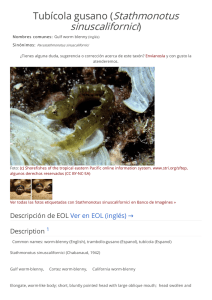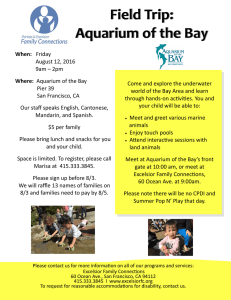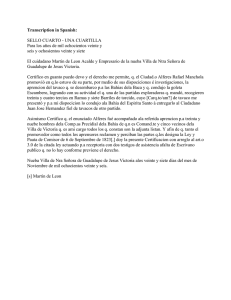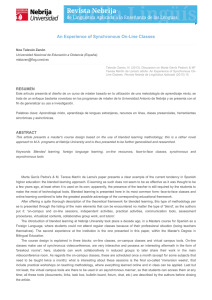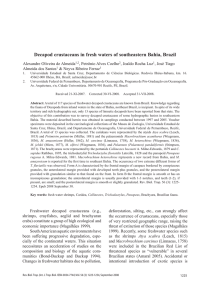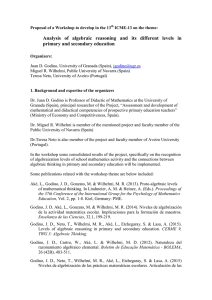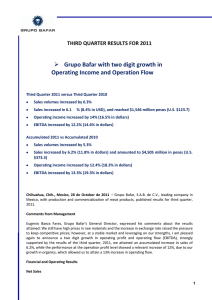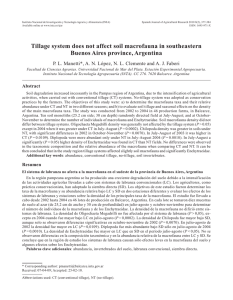English
Anuncio
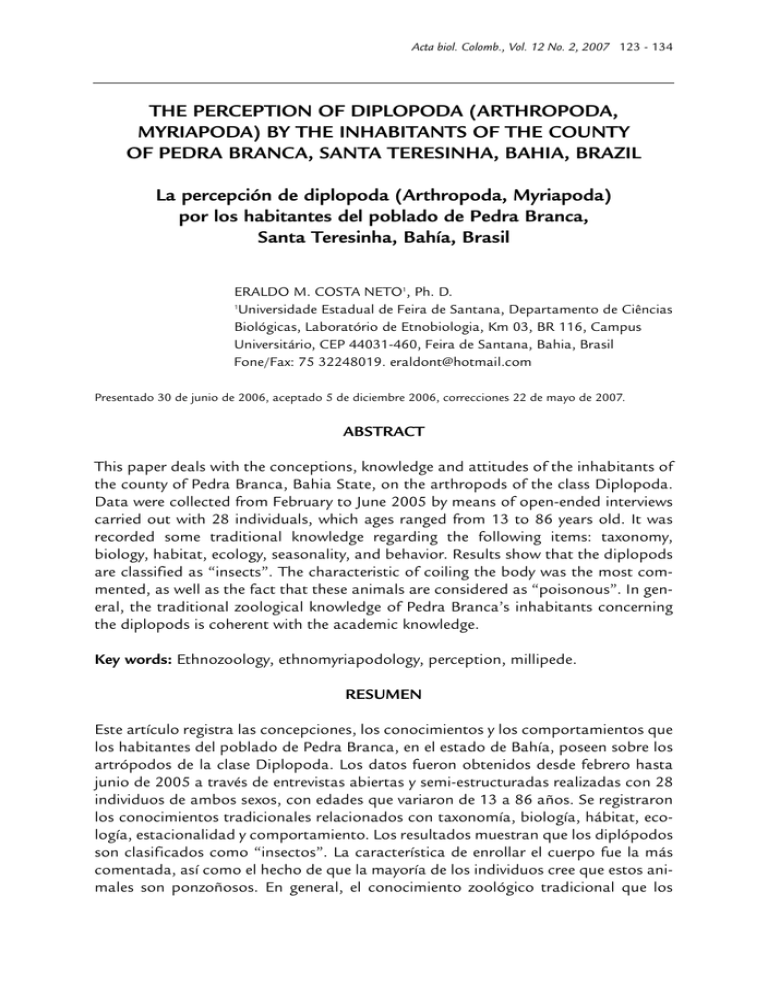
Acta biol. Colomb., Vol. 12 No. 2, 2007 123 - 134 THE PERCEPTION OF DIPLOPODA (ARTHROPODA, MYRIAPODA) BY THE INHABITANTS OF THE COUNTY OF PEDRA BRANCA, SANTA TERESINHA, BAHIA, BRAZIL La percepción de diplopoda (Arthropoda, Myriapoda) por los habitantes del poblado de Pedra Branca, Santa Teresinha, Bahía, Brasil ERALDO M. COSTA NETO1, Ph. D. 1 Universidade Estadual de Feira de Santana, Departamento de Ciências Biológicas, Laboratório de Etnobiologia, Km 03, BR 116, Campus Universitário, CEP 44031-460, Feira de Santana, Bahia, Brasil Fone/Fax: 75 32248019. [email protected] Presentado 30 de junio de 2006, aceptado 5 de diciembre 2006, correcciones 22 de mayo de 2007. ABSTRACT This paper deals with the conceptions, knowledge and attitudes of the inhabitants of the county of Pedra Branca, Bahia State, on the arthropods of the class Diplopoda. Data were collected from February to June 2005 by means of open-ended interviews carried out with 28 individuals, which ages ranged from 13 to 86 years old. It was recorded some traditional knowledge regarding the following items: taxonomy, biology, habitat, ecology, seasonality, and behavior. Results show that the diplopods are classified as “insects”. The characteristic of coiling the body was the most commented, as well as the fact that these animals are considered as “poisonous”. In general, the traditional zoological knowledge of Pedra Branca’s inhabitants concerning the diplopods is coherent with the academic knowledge. Key words: Ethnozoology, ethnomyriapodology, perception, millipede. RESUMEN Este artículo registra las concepciones, los conocimientos y los comportamientos que los habitantes del poblado de Pedra Branca, en el estado de Bahía, poseen sobre los artrópodos de la clase Diplopoda. Los datos fueron obtenidos desde febrero hasta junio de 2005 a través de entrevistas abiertas y semi-estructuradas realizadas con 28 individuos de ambos sexos, con edades que variaron de 13 a 86 años. Se registraron los conocimientos tradicionales relacionados con taxonomía, biología, hábitat, ecología, estacionalidad y comportamiento. Los resultados muestran que los diplópodos son clasificados como “insectos”. La característica de enrollar el cuerpo fue la más comentada, así como el hecho de que la mayoría de los individuos cree que estos animales son ponzoñosos. En general, el conocimiento zoológico tradicional que los 124 Artículo de Reflexión - The perception of Diplopoda (Arthropoda, Myriapoda) by the inhabitants of the county of Pedra Branca, Santa Teresinha, Bahia, Brazil. Costa pobladores de Pedra Branca tienen acerca de los diplópodos se mostró coherente con el conocimiento académico. Palabras clave: Etnozoología, etnomiriapodología, percepción, milpiés. INTRODUCTION Millipedes are arthropods that may be found all over the world except Antarctica (Hoffman et al., 2002). They constitute the largest group of Myriapoda (Ruppert et al., 2005). Approximately 11 thousand species/subspecies have been already recorded, and they are allocated in more than 4,500 genera, 170 families and 15 orders (Hoffman et al., 2002). According to these authors, knowledge on the animals of this group in Neotropical regions is restricted to 1,100 species/subspecies, 800 genera, 47 families, and 13 orders. Most of its specific richness and diversity concentrates in the tropical and subtropical areas of the world (Sielfeld, 2002). Nine out of the eleven orders included in the superorder Helminthomorpha occur in the Neotropics, but Polydesmida, Spirostreptida and Spirobolida are dominant (Hogue, 1993). This author says that diplopodofauna from Latin America is diverse, but very little studied. Brazilian species are not well defined regarding their classification and geographical distribution (Knysak and Martins, 1999). Hoffman (review by Hogue, 1993) recorded about 470 species for Brazil. In Brazil they are popularly known as gongos, gongolos, gongolôs, caramugis, emboás, embuás, ambuás, imbuás, bichos-do-ouvido and piolhos-de-cobra (Santos, 1982; Nomura, 2001). Diplopods have their body divided into a head, which bears a pair of short antennae with eight segments, a trunk, and a telson (Hopkin and Read, 1992). They differ from other myriapods for having two pairs of legs per segment (except the first four segments; Ruppert et al., 2005). They vary largely in size, ranging from species with only 2-3 mm length, such as Polyxenus lagurus (Linnaeus, 1758), to those species with 28 cm length and a trunk with more than 80 segments, such as Graphidostreptus gigas (Peters, 1855; Ramel, 2005). Illacme plenipes Cook & Loomis, 1928 has the biggest number of legs presenting 375 pairs (Ramel, 2005). They are gonocorical animals; in most of the taxa one of the two or both legs of the seventh segment of the males are modified in copulatory gonopodia (Hopkin y Read, 1992; Ruppert et al., 2005). Diplopods are detritivorous and play an important role in the reduction of litter and soil formation. Although these arthropods do not present cephalic venom inoculating fangs (Guenneugues and Ménez, 1997), some species may cause dermatological problems (Cardoso and Haddad Júnior, 2003), as well as they can constitute elements of phytosanitary importance (Boccardo et al., 1997; Boccardo et al., 2002; Garcia and Campos, 2001). There is little information available in the literature about the perception, classification, and traditional uses of diplopods by human societies, which usually present negative attitudes towards these and other arthropods. However, some more positive reactions are observed when, for example, the anthropomorphized image of a millipede is used in shoe advertisement by obvious reasons (Costa Neto, 2000). Due to Acta biol. Colomb., Vol. 12 No. 2, 2007 125 the way they move, diplopods are investigated in scientific research in robotics to transport heavy loads under limited conditions, where many turns and curves are needed (Beattie and Ehrlich, 2001). Diplopods also find some significance in religion, mythology, and traditional medical practices from different cultures. In 1983, Davis published a study on the ethnopharmacology of the poison prepared by the Voodoo priests of Haiti used to transform innocent victims into living-dead slaves (zombies). Millipedes were one of the several ingredients used. As medicinal resources, the Azteca used to employ live millipedes to alleviate toothache by holding coiled specimens against the cheek (Curran, 1937). Still in Mexico, diplopods (probably Lulus terrestris Linnaeus, 1758) are used to treat joint illnesses, together with herbs, snakes, and scorpions; all that is boiled, powdered and put as a plaster on the affected area (Barajas, 1961). In Zambia, Africa, several species, including Lophostreptus cameranii Silvestri, 1896, Proteroiulus fuscus (Am Stein, 1857), Ommatoiulus moreleti (Lucas, 1860), Brachyiulus pusillus (Leach, 1815) and Allajulus latestriatus (Curtis, 1845) are smashed and the resulting mass is used topically to treat wounds (Mbata, 1999). For the Bafia people from the Cameroon Republic, the juice of a millipede (Spirostreptus sp.) is recommended in cases of earache (Guarisma, 2003). In Alagoas State, northeastern Brazil, Amorim (1963) recorded the following medical recommendation: a living millipede is crushed, then some water is added, and then the mixture is drunk as medicine against asthma. In the state of Bahia, people recommend smashing a whole diplopod and rubbing this mass on zits, chilblains and feet cracking (Costa Neto, 1999a). Considering that ethnozoological studies on Diplopoda are rare in Brazil (Domingues et al., 2003), the present paper deals with the conception, knowledge and behavior of a small community from Bahia State about millipedes. A new branch of ethnozoology is proposed here: ethnomyriapodology, which is defined as the transdisciplinary study of the human/myriapods relationships. MATERIALS AND METHODS Data presented here are part of a broader research project that aims to record the ethnozoology of the inhabitants of Pedra Branca village. This human settlement is located in the west central region of Bahia State, northeastern Brazil. It is inside the municipality of Santa Terezinha (which is also the capital), but it is about 13 km away from it. It is situated at the base of the Serra da Jibóia, a mountain range of about 225 km2 of area whose peak elevation is 805 m above sea level. It lies between 12º46’ south latitude and 39º32’ west longitude (Juncá et al., 1999). The region, which is totally included in the Drought Polygon, has a semi-arid climate with an average annual temperature of 24.3 ºC and an average annual rainfall of 582 mm. The rainy period lasts from November to January. The soil is good for agricultural activities and not bad for livestock-raising (Centro de Estatística e Informações, 1994). Data were obtained from February to June 2005 by means of open-ended interviews using the pattern techniques of the ethnographical research focused on the cognitive anthropology (Sturtevant, 1964). An Open and Clarified Consent Term was done based on the Resolution 196/96. It was read and distributed among those villagers who participated in the study. People of both genders whose ages ranged from 13 to 86 126 Artículo de Reflexión - The perception of Diplopoda (Arthropoda, Myriapoda) by the inhabitants of the county of Pedra Branca, Santa Teresinha, Bahia, Brazil. Costa years old were interviewed. The main objectives of the research were explained clearly in the beginning of each new interview asking the people if they wanted to participate. Researcher maintained visual contact with the interviewees using a micro taperecorder; semi-literal transcriptions are kept at the Laboratory of Ethnobiology of the Universidade Estadual de Feira de Santana (UEFS). Glass jars filled with 70% alcohol were left in some residencies in order to get diplopod species from the area and to make a survey about the collected specimens. Projective tests were possible thanks to these collections, when people were inquired about the content and the common names, the local impressions on the animals, and their uses were noted down. Different animals were frequently keept in these jars: lizards, toads, frogs, scorpions, spiders, insects, and centipedes. Field trips in the surroundings of the village were also done in order to collect diplopods. All specimens were taken to the UEFS for taxonomical identification. Data were analyzed using the union model, which involves considering all available information on the surveyed subject (review by Marques, 1991). Controls were performed both through consistency checking tests and reply validity tests, which make use of repeated inquiries in synchronic and diachronic conditions, respectively (Marques, 1991). The former occurred when the same question was asked to different people in very close times; the latter occurred when the same question was asked to the same person in different moments. RESULTS AND DISCUSSION ETHNOTAXONOMY OF THE MILLIPEDES Diplopod species are generically known as gongos or ingongos in the village of Pedra Branca. The common label piolho-de-cobra, which names millipede species in other Brazilian regions, in this town is used to refer to those centipedes of the Geophilomorpha Order. People usually compare the millipedes to the centipedes (Chilopoda), since both animals present an extended body and many pairs of legs. The phylogenetic relationship between Chilopoda and Diplopoda is evidenced in the following testimony: “The santopéia is a nation of gongo, isn’t it? It is a relative. I say it is a relative” (Mrs. M., 59 years old). However, some inhabitants differentiate the centipedes from the millipedes in terms of body size and due to the ability these latter have to roll up their bodies: “The lacrau is larger. The gongo is round” (Mr. Z., 47 years old); “The gongo is smaller” (Dona N., 58 years old). It is interesting to note that the lexeme lacrau is also used to designate the scorpions in Brazilian countryside. A study about the ethnozoological aspects of diplopods, carried out with some citizens from the city of Jequié, Bahia State has revealed that the term gongo appears with a higher frequency (83%). Other local names were also recorded such as piolho-de-cobra, minhoca, and lagarta (Domingues et al., 2003). Although the several types of millipedes that exist in the surveyed region do not receive specific popular names, they are mainly differentiated based on the color of their tegument: “There is white, black, red” (Mrs. D., 70 years old); “There is a yellow big Acta biol. Colomb., Vol. 12 No. 2, 2007 127 one” (Mrs. E., 60 years old); “There is one whose back is silverish” (L., 28 years old); “Red, black, dark yellow and another yellow, flattened and full of legs that resembles the lacraia” (Mrs. V., 58 years old). Literature records that most diplopods show a black coloration and brown tints, but many show brilliant and remarkable colors, including orange, red, yellow, blue, and green (Ruppert et al., 2005). There are also some cases of bioluminescence, such as it is shown by most species of Motyxia (Luminodesmus; Polydesmidae) from the south of California (Ramel, 2005). In the local imaginary, there is a kind of millipede that changes into a centipede: “There is a big one that turns into a lacraia. It is gross. Now it is full of that yellow big leg” (Mrs. D., 70 years old). This traditional knowledge concerning the ontogeny and biological transformations of the organisms is important because it affects the way people perceive and classify the existent relationships among different categories of animals (Ellen, 1985). The isomorphic relationship expressions, such as “nation of” and “a kind of”, denote classificatory similarity between those elements that are compared with each other. This way, researchers carrying out studies on ethnozoological classification must be attentive both to the ontogeny and biotransformation processes, since they are meaningful in the formation and structuration of the zoological cognitive categories of a given ethnobiological classification system (Costa Neto, 2004). THE CULTURAL CONSTRUCTION OF THE ETHNOTAXON gongo IN PEDRA BRANCA VILLAGE In what it concerns the zoological ethnotaxonomy recorded in Pedra Branca, millipedes as well as all other arthropods and some non-arthropod animals (rat, bat, lizard, serpent, toad, slug, earthworm, and others) are perceived and classified as “insects”. As one interviewee stated regarding the millipede: “It is a disgusting insect” (Mrs. D., 70 years old). This kind of folk cognitive construction is identified as an ethnotaxonomical complex within the ethnobiological classification systems (Berlin, 1992). Thereby, cognitive categories cannot be considered as universal and, therefore, one should go for a methodological approach that permits “to discover” the conceptual paradigms instead of imposing them on the society under study (Posey, 1983). The junction of animals with so varied evolutive histories in just one culturally constructed taxon has been observed in different social-cultural contexts, both ancient and contemporary. Aristotle included insects, arachnids, myriapods, and worms in the Entoma group (Morge, 1973). In the Biblical times the Hebraic term sheretz was used to refer to all those crawling creatures, like reptiles, mollusks, amphibians, arthropods, and, possibly, small mammals (Harpaz, 1973). The Azteca people classified centipedes, millipedes and small lizards as insects (Curran, 1937). The Pälawan people from The Philippines use the term rämu-rämu to designate all the small animals, including those that bite, sting and suck human blood (Revel, 1990). The Kayapó Indians who live in the state of Pará, North Brasil classify the millipedes and other arthropods as maja, which means “shell-less and fleshless animals” (Posey, 1983). The Waurá Indians who inhabit in the region of the Alto Rio Xingu, in the northeast of the Mato Grosso State, have the word yakawaka that is the corresponding category to the “small bugs with many legs that fly or not” (Barcelos Neto, 2000). 128 Artículo de Reflexión - The perception of Diplopoda (Arthropoda, Myriapoda) by the inhabitants of the county of Pedra Branca, Santa Teresinha, Bahia, Brazil. Costa According to Costa Neto and Pacheco (2005), the ethnozoological dominium “insect” seems to occur as a pattern in the ethnobiological classification systems (paying attention, however, to the native equivalent terms and to the unnamed categories). This pattern has been explained by means of the entomoprojective ambivalence hypothesis. According to it, human beings tend to project feelings of noxiousness, dangerousness, edginess, repugnance and under-estimation to those non-insect animals, and thus associate them to the “insect” category culturally determined (Costa Neto, 1999b). The idea of ambivalence is employed in the sociological sense, which refers to the positive and negative attitudes one presents towards things or people. Projection results from the psychological process by which the individual attributes his own conflicts to another being. ETHNOBIOLOGICAL KNOWLEDGE ON MILLIPEDES In consideration of morphology, the following testimony about internal organs was recorded: “The bowls of the gongo are all complete. It’s like brains” (Mr. E., 66 years old). Probably, this interviewee made this comment taking into account that when a millipede suffers a section in its body the digestive apparatus almost always comes together. Ruppert et al. (2005) state that the digestive tract of these animals is typically a right-angle tube with a long middle intestine. According to the interviewed people, millipedes are found in rotten woods, baseboard, firewood, and in the litter. A big specimen inhabits the caatinga, which is the Brazilian biome from the northeastern of the country (“The yellow big one only appears in the caatinga”, Mrs. E., 60 years old). Another large one is found preferentially on the lower side of the Serra da Jibóia (“The big species lives more often on the hill. Here in the low-lands it is not able to survive. It is always on the slopes”, L., 28 years old). Apparently, interviewees are referring to the millipedes of the Spirostreptidae family and Spirostreptida order (Fig. 1). Figure 1. Spiraled millipede (Spirostreptida: Spirostreptidae) collected on Serra da Jibóia hills, Santa Terezinha, Bahia, Brazil. Acta biol. Colomb., Vol. 12 No. 2, 2007 129 Diplopods are mesophilous and hygrophilous animals that generally present nocturnal habits. They are always escaping from the sunlight, and therefore are found hidden in humid and dark places, such as under litter, mosses, stones or pieces of wood, inside rotten trunks or on the soil surface (Garcia and Campos, 2001). Sometimes they make migrations searching for humidity (Santos, 1982), or are associated to reproduction (Boccardo et al., 2002). Then they invade homes and damage vegetable gardens, orchards, and small plantations (Boccardo et al., 1997; Boccardo et al., 2002). Most of the interviewees stated that these animals are more active during the rain time: “When it rains they enjoy going out” (Mrs. V., 58 years old); “They appear more often in times of rain” (Mrs. E., 60 years old). There is probably a correspondence between the seasonality of their appearance and the period of rains, since diplopods are considered as indicators of weather conditions in the folk meteorology. There is even a common saying: “embuá travelling, rain coming” (Nomura, 2001). For the people from the county of Tanquinho, Bahia State, the presence of many white millipedes in the beginning of the winter is interpreted as a signal that there will be nonstop rains and that crops of the coming period will be good (Oliveira, 2006). César (1941 in Nomura, 2001) claims that in those years, when millipedes appear on the roads and fields, winter will be good. Fruits Cattle manure Birds Mushroom Gongo Spider Manioc Figure 2. Millipede’s trophic model according to the interviewed inhabitants. The food habit of the gongo was also recorded. A schema of trophic model based on the Pedra Branca villagers’ traditional knowledge is shown in figure 2. According to them, diplopods feed on fruits, cattle manure, mushrooms and pieces of manioc stem. On the other hand, they are eaten by spiders and birds, like the anum (Cuculidae family). Diplopods are herbivorous and detritivorous and they feed mainly on decomposing vegetation, but some species eat animal substances such as the lysiopetalids that inhabit rocks (Santos, 1982; Ruppert et al., 2005). In some tropical regions these animals are more important than earthworms in what it concerns to soil recycling once when they feed on decomposing plant material eating fungi, bacteria, and the material they have already torn in pieces (Ramel, 2005). Some species attack living plants and sometimes cause serious problems in greenhouses and gardens (Garcia and Campos, 2001). These authors claim that diplopods may reach plague levels. That is why their phytosanitary importance should be taken into consideration. 130 Artículo de Reflexión - The perception of Diplopoda (Arthropoda, Myriapoda) by the inhabitants of the county of Pedra Branca, Santa Teresinha, Bahia, Brazil. Costa Millipedes’ ability of coiling their bodies was commented by nine individuals, and two of them recognized a defense mechanism in this attitude: “The gongo… its defense… when we mess with it, it protects itself, it rolls up” (Mr. E., 66 years old). Only one interviewee associated the behavior of rolling up (“ingongar”, a verb created from the animal’s popular name, as he said) with the sex of the animal: “The one that rolls up is the female. The male, the more you mess with it, the more it goes away” (A., 40 years old). Literature records that in many diplopods both sexes are capable of executing a dorsoventral flexion and roll their bodies in spirals when resting or disturbed, and thus providing greater rigidity through body contraction into a small block (Moore, 2003). Members of the Glomerida order (Oniscomorpha superorder), as well as some other orders can roll up in spheres (Ruppert et al., 2005). Another advantage of this spiraled formation is reducing the loss of water on body surface when the surroundings get less humid (Meglitsch and Schram, 1991). Additionally, it provokes the excretion of a liquid from the repugnatory glands, which has the function of repelling the natural enemies (Hopkin and Read, 1992; review by Nomura, 2001). Few species have developed the habit of ejecting their corporal fluids up to 20 or 30 centimeters away. The natives from Malaysia use this defensive secretion as arrow poison (Ruppert et al., 2005). Rhinocrisis, from Haiti, can spray its noxious secretion up to almost one meter away (Meglitsch and Schram, 1991). “OFFENSIVE” MILLIPEDES In what it concerns the local perception on millipede noxiousness (“offensive”), 41% of the interviewees stated that the gongo hurts (“It has a poison like that of the snake’s”, Mrs. P., 72 years old). However, 23% of them have considered it harmless (“This animal is the traveler which never hurts anyone”, Mr. E., 66 years old; “It is a small bug that bothers nobody”, Mr. A. M., 78 years old). In the city of Jequié Domingues et al. (2003) have obtained different results: 58% of the people claimed these animals are not poisonous, against 32% who considered them noxious. In Pedra Branca, if someone is injured by a millipede, he/she has to count all its legs. Such a procedure however is generally taken as a superstition: “I want to see who is going to count the legs of a millipede!” (Mrs. P., 72 years old); “I never saw a millipede biting” (E., 38 years old); “It never injured anybody, but on the day it hurts someone has to count all its legs. But did you count them? This is a legend” (Mrs. E., 60 years old). Even though, millipedes are exterminated with insecticide. It is interesting to note the perceptions of noxiousness people from Jequié have attributed to millipedes: “If it spits fire someone has to count its 100 legs”; “When it bites or rolls up, it only releases the victim and the person only survives if he/she counts its legs”; “When it bites there is no cure unless you toast its skin (exoskeleton) and put the powder on the affected area”; “If it stings it makes a kind of cancer and that eats up the body”; “The little one may enter their ears when people are sleeping” (Domingues et al., 2003). Although the accidents caused by diplopods do not present serious consequences, they still give rise to troubles and must be viewed with some concern. Accident occurs when the animal is compressed against the skin. This can happen when someone puts his shoes on. The main component of the diplopods’ Acta biol. Colomb., Vol. 12 No. 2, 2007 131 secretion varies according to the species: aldehydes, quinones, phenols and hydrogen cyanide. As Cardoso and Haddad Júnior (2003) state, the corporal fluids can provoke erythema, edema, bladders, and brown or black pigmentation around the affected skin. It can evolve to residual hypocromy, also being reported hypercromic lesions that can persist for months (for instance, the Mexican species of the Orthoporus genus Fernández-Rubio, 1997). If the caustic substance reaches the eye it can cause intense ache, with acute conjunctivitis, burn sensation and having the same effect as chemical burning (Fernández-Rubio, 1997). The use of alcohol and ether on the area is encouraged because they function as solvents of the venoms. The risk of having an accident with corporal fluids was not neglected in the traditional medical systems of indigenous peoples. The Yora/ Yaminahua Indians from the Peruvian Amazon attribute several sicknesses to the evil spirits of noxious invertebrates, such as wasps (wina) and caustic diplopods (xaco). Many of the respiratory conditions are associated, directly and indirectly, to these latter that probably belong to the Spirobolida or Spirostreptida order. Eating food or drinking water contaminated with the caustic secretions causes itching in the throat, cough and production of mucus with blood, a condition that is known as xaco xea, or “swallowed diplopod” (Shepard Junior, 1999). On the other hand, the pharmaceutical industries should search new chemical structures in diplopods for discovering biologically active compounds. Some animals present a behavior of selfmedication (zoopharmacognosy) and that can point out to that direction. In Venezuela, capuchin monkeys (Cebus olivaceus Schomburgk, 1848) rub the highly toxic diplopod secretions on their bodies during rainy seasons, when insect bites (especially of mosquitoes) are merciless. These secretions are antimicrobial and contain insect repellents called benzoquinones (Valderrama et al., 2000; Engel, 2002). CONCLUSION In general, Pedra Branca inhabitants’ traditional zoological knowledge regarding millipede species has shown to be rationally coherent with the academic knowledge. The complex set of feelings, knowledge and behavior towards this animal group and other arthropods may as well be translated as a valuable cultural resource, which in turn has to be taken into account both in the developmental processes addressed to the region - maybe the transformation of it in some kind of Conservation Unity, and in studies of local fauna inventory. ACKNOWLEDGMENTS Lilian Boccardo of the Universidade Estadual do Sudoeste da Bahia for having reviewed and commented an earlier draft, and Cláudia Cunha Kachimareck for her English corrections. 132 Artículo de Reflexión - The perception of Diplopoda (Arthropoda, Myriapoda) by the inhabitants of the county of Pedra Branca, Santa Teresinha, Bahia, Brazil. Costa REFERENCES AMORIM JP. Medicina popular em Alagoas. Maceió: Departamento Estadual de Cultura; 1963. BARAJAS ECL. Los animales usados en la medicina popular mexicana. México: Imprenta Universitaria; 1961. BARCELOS NETO A. Monstros amazônicos. Imagens Waurá da (sobre) natureza. Ciência Hoje. 2000;27(162):48-53. BEATTIE A, EHRLICH PR. Wild Solutions: How Biodiversity is Money in the Bank. New Haven: Yale University Press; 2001. BERLIN B. Ethnobiological Classification: Principles of Categorization of Plants and Animals in Traditional Societies. New Jersey: Princeton University Press; 1993. BOCCARDO L, PENTEADO CHS, JUCÁ-CHAGAS R. Swarming of Millipedes, a New Case Noticed in the District of Patrocínio-MG-Brazil. J Advanced Zool. 1997;8(1):62-63. BOCCARDO L, JUCÁ-CHAGAS R, PENTEADO CHS. Migration and Population Outbreaks of Millipedes in the Coffee Plantations, Region of Alto Paranaiba, MG, Brazil. Holos Environm. 2002;2(2):220-223. CARDOSO JLC, HADDAD JÚNIOR V. Acidentes por coleópteros vesicantes e outros artrópodes. En: Cardoso JLC, França, FOS, Wen, FH, Málaque, CMS, Haddad Júnior V, organizers. Animais peçonhentos no Brasil: biologia, clínica e terapêutica dos acidentes. São Paulo: SARVIER; 2003. p. 258-264. CENTRO DE ESTATÍSTICA E INFORMAÇÃO. Informações básicas dos municípios baianos: recôncavo sul. Salvador: Governo do Estado da Bahia; 1994. p. 543-563. COSTA NETO EM. “Barata é um santo remédio”: introdução à zooterapia popular no estado da Bahia. Feira de Santana: UEFS; 1999a. COSTA NETO EM. A etnocategoria “inseto” e a hipótese da ambivalência entomoprojetiva. Acta Biol Leopoldensia. 1996b;21(1):7-14. COSTA NETO EM. O uso de estímulos-sinais entomomorfos na publicidade. Bioikos. 2000;14(1):49-53. COSTA NETO EM. Biotransformações de insetos no povoado de Pedra Branca, estado da Bahia, Brasil. Interciencia. 2004;29(5):280-283. COSTA NETO EM, PACHECO JM. A construção do domínio etnozoológico “inseto” pelos moradores do povoado de Pedra Branca, Santa Terezinha, estado da Bahia. Acta Scientiarum Biol Science. 2004;26(1):81-90. CURRAN CH. Insect lore of the Aztecs. Nat Hist. 1937;39:196-203. DAVIS EW. The Ethnobiology of the Haitian Zombie. J Ethnopharm. 1983;9:85-104. DOMINGUES AMT, OLIVEIRA CG, RANGEL LS, ROMÃO JA, PEIXOTO AV, BOCCARDO L. Identificação das representações sobre diplópodos por populares, no município de Jequié, BA. En: Anais do VII Seminário de Iniciação Científica da UESB. Vitória da Conquista: UESB; 2003. p. 210-211. ENGEL C. Wild Health. How Animals Keep Themselves Well and What We Can Learn from Them. New York: Houghton Mifflin Company; 2002. Acta biol. Colomb., Vol. 12 No. 2, 2007 133 FERNÁNDEZ-RUBIO F. Artrópodos y salud humana. Bol SEA. 1997;20:67191. GARCIA FRM, CAMPOS JV. Biologia e controle de artrópodes de importância fitossanitária (Diplopoda, Symphyla, Isopoda), pouco conhecidos no Brasil. Biológico. 2001;63(1/2):7-13. GUARISMA G. Insectes nuisibles, bienfaiteurs, protecteurs et médicinaux chez les Bafia (Cameroun). En: Motte-Florac E, Thomas JMC, editors. Insects in oral literature and traditions. Paris-Louvain: Peeters-SELAF (Ethnosciences); 2003. p. 381393. GUENNEUGUES M, MÉNEZ A. Structures et Fonctions de Toxines Animales. Comptes Rendus Séances Soc Biol. 1997;191(3):329-344. HARPAZ I. Early Entomology in the Middle East. En: Smith RF, editor. History of entomology. Palo Alto: Annual Reviews Inc.; 1973. p. 21-36. HOGUE CL. Latin American Insects and Entomology. Berkeley: University of California Press; 1993. HOFFMAN RL, GOLOVATCH SI, ADIS J, MORAIS JW. Diplopoda. En: Adis J, editor. Amazonian Arachnida and Myriapoda. Pensoft, Sofia (Moscow); 2002. p. 505-533. HOPKIN SP, READ HJ. The Biology of Millipedes. Oxford: Oxford University Press; 1992. JUNCÁ FA, FREITAS MA, ALVES L, GUERREIRO W, PASCHOAl E. Herpetofauna da Serra da Jibóia - Bahia: novas ocorrências. En: Resumos do 12 Encontro de Zoologia do Nordeste. Feira de Santana: UEFS; 1999. p. 412. KNYSAK I, MARTINS R. Myriapoda. En: Joly CA, Bicudo CEM, organizers. Biodiversidade do Estado de São Paulo, Brasil: síntese do conhecimento ao final do século XX. São Paulo: FAPESP; 1999. p. 67-72. MARQUES JGW. Aspectos ecológicos na etnoictiologia dos pescadores do Complexo Estuarino-lagunar Mundaú-Manguaba [tesis de doctorado]. Campinas: Universidade Estadual de Campinas; 1991. MBATA KJ. Traditional Uses of Arthropods in Zambia: II. Medicinal and Miscellaneous Uses. The Food Insects News. 1999;12(2):1-7. MEGLITSCH PA, SCHRAM RF. Invertebrate Zoology. 3 ed. Oxford: Oxford University Press; 1991. MOORE J. Uma introdução aos invertebrados. São Paulo: Santos Editora; 2003. NOMURA H. Os animais no folclore: aracnídeos e miriápodos. Mossoró: Fundação Vingt-Um Rosado; 2001. OLIVEIRA MVM. 2006. Prevendo o tempo em Tanquinho, Bahia. Sitientibus ser C Biol; 2002;6:120-124. POSEY DA. O conhecimento entomológico Kayapó: etnometodologia e sistema cultural. Anuário Antrop. 1983;81:109-121. REVEL N. Fleurs de Paroles. Histoire Naturelle Palawan I: Lens dons de Nägsalad. Paris: Editions Peeters; 1990. RUPPERT EE, FOX RS, BARNES RD. Zoologia dos invertebrados: uma abordagem funcional-evolutiva. 7 ed. São Paulo: Editora Roca; 2005 134 Artículo de Reflexión - The perception of Diplopoda (Arthropoda, Myriapoda) by the inhabitants of the county of Pedra Branca, Santa Teresinha, Bahia, Brazil. Costa SANTOS E. O mundo dos artrópodes. Belo Horizonte: Itatiaia; 1982. SHEPARD JUNIOR GH. Pharmacognosy and the Senses in Two Amazonian Societies [tesis de dosctorado]. Berkeley: University of California; 1999. SIELFELD W. Clase Diplopoda. Guías de identificación y biodiversidad fauna chilena. Apuntes de Zoología. Iquique: Universidad Arturo Prat; 2002. STURTEVANT WC. Studies in ethnoscience. Am Anthrop. 1964;66(3):99-131. VALDERRAMA X, ROBINSON JG, ATTYGALE AB, EISNEr T. Seasonal Anointment with Millipedes in a Wild Primate: A chemical Defense Against Insects? J Chem Ecol. 2000;26:2781-2790.

